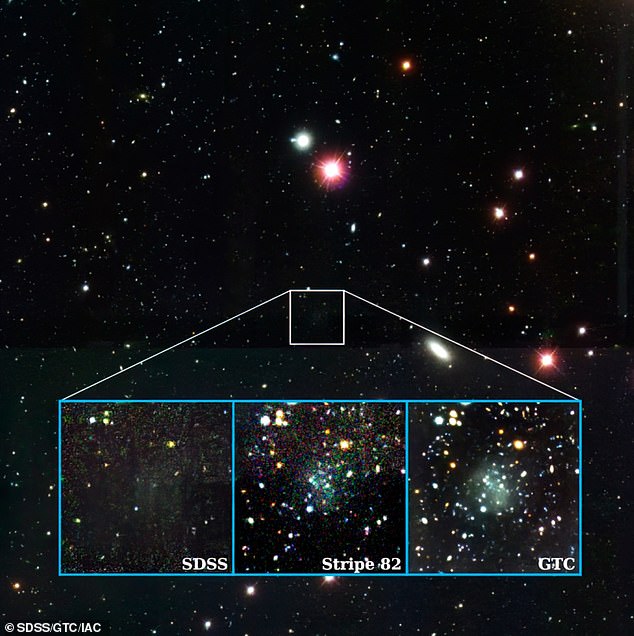Astronomers discovered a nearly invisible dwarf galaxy that cannot be explained with our current understanding of the universe.
The mysteriously faint formation, which has been called the Cloud, is unique due to its high levels of dark matter and low mass at its center.
These unusual attributes mean that Cloud’s stars are widely dispersed and therefore the galaxy barely emits any light, allowing it to evade detection for years.
The galaxy is 10 times fainter than most galaxies of the same size.
“With our current knowledge we do not understand how a galaxy with such extreme characteristics can exist,” according to Mireia Montes, lead author of the study and an astrophysicist at the Institute of Astrophysics of the Canary Islands.
Researchers discovered the dwarf galaxy, called the Cloud, using data from the Sloan Digital Sky Survey
Scientists believe the galaxy is 300 million light years from the Milky Way, but more research is needed to determine its exact location.
It was discovered by researchers from the Institute of Astrophysics of the Canary Islands (IAC) and the University of La Laguna (ULL).
Nube, which means cloud in Spanish, got its name from its almost dark galaxy appearance with only a small amount of mass at its center.
Researchers involved in the study said finding the galaxy is important because its faint glow, caused by large amounts of dark matter, has allowed it to evade detection.
Dark matter is the absence of light or energy, making it completely invisible, so conventional sensors and detectors cannot find it.
The researchers analyzed data from the Sloan Digital Sky Survey and noticed an inconsistency that caused them to take a closer look at the findings.
They took ultra-deep multicolor images of the anomaly with the Green Bank Telescope (GBT) and the Gran Telescopio Canaria (GTC) and upon discovering the dwarf galaxy they wondered how it could hold together when there is such a small amount of mass. in its center.

The researchers took three separate images using the Sloan survey and multicolor photographs using the Green Bank Telescope (GBT) and the Gran Telescopio Canaria (GTC).
The mass would normally act as a gravitational pull to hold stars in place, but the galaxy’s existence despite its limited mass contradicts astronomers’ previous claims that dark matter needs high levels of mass to exist.
“An attractive possibility is that Cloud’s unusual properties show us that the particles that make up dark matter have extremely small mass,” said study co-author Ignacio Trujillo, an astrophysicist at the Institute of Astrophysics of the Canary Islands. .
He added that if dark matter were composed of a small mass, ‘it would be one of the most beautiful demonstrations of nature, unifying the world of the smallest with that of the largest.’
However, this is just one possibility, and researchers involved in the study said more research still needs to be done, but their findings could change the way scientists view dark matter and the universe.
“We have known for a long time that the current model of cold dark matter does not fully explain certain properties of the galaxies we see,” says Dr. Mireia Montes, lead author of the study and researcher at the IAC and the ULL. Dailymail.com.
He said this type of galaxy can help researchers discover more information about dark matter, and although they cannot fully explain what they know now, they have to resort to questioning the properties of dark matter.
“I think the most obvious outcome is to gradually test and improve what we already know to better understand our universe,” Montes said, adding, “But the potential is enormous.”


